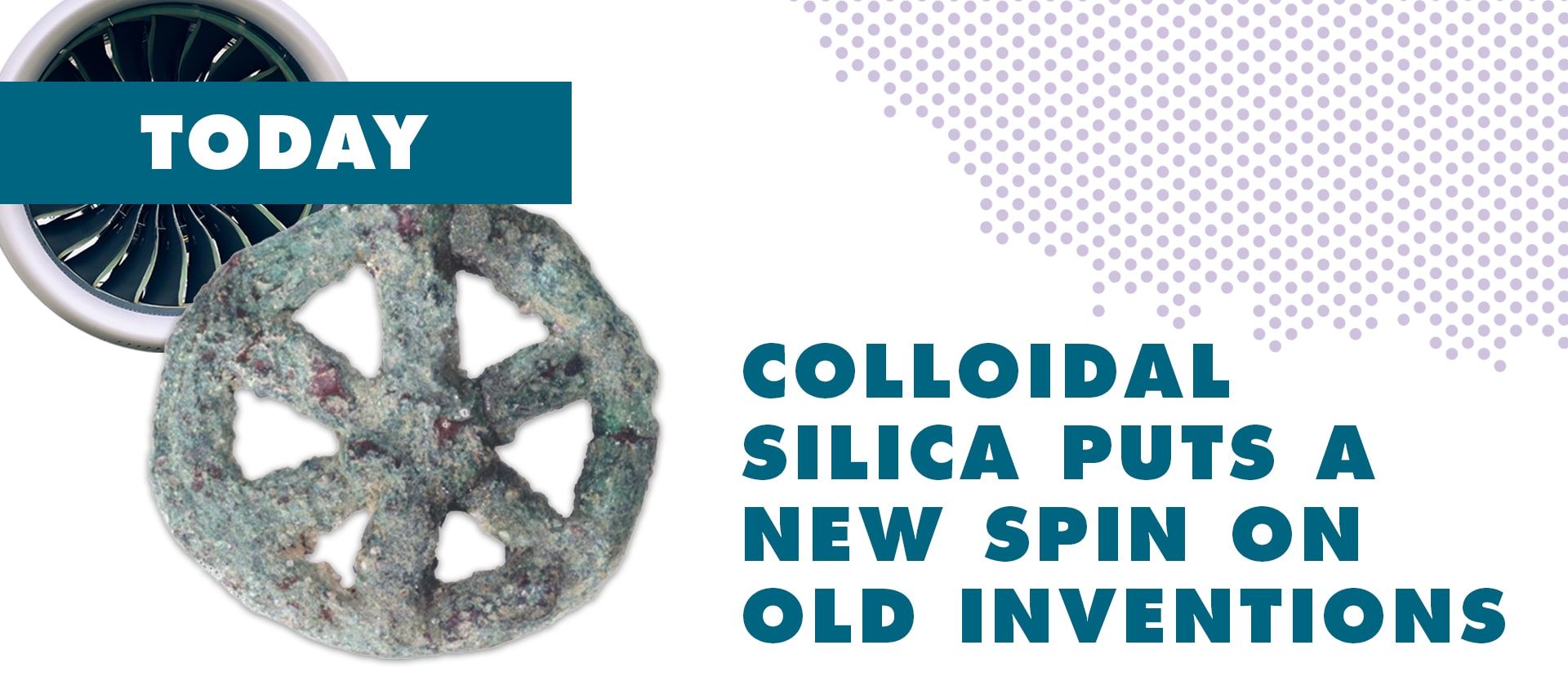150 years of research and development have transformed colloidal silica from a scientific oddity to a mainstay of industrial manufacturing of products ranging from floor wax to jet engines
By Michael Eisenstein, C&EN BrandLab contributing writer
Every child playing on a beach knows that when they mix sand and water in a bucket, sooner or later, a layer of wet sediment will settle at the bottom of the bucket. What they may not know is that, in 1861, British chemist Thomas Graham discovered that a little chemical coaxing could cause the same wet sediment—solid silicon dioxide particles—to remain suspended, creating a liquid mixture with surprising and distinctive properties.
By combining sodium silicate, a compound derived from silicon dioxide, with water and acid, Graham produced clear liquid samples in which the resulting sodium silicate compound formed particles that were too bulky to pass through a filter, while also remaining suspended in a solution-like state. Graham identified a number of such mixtures and, based on their unusual behavior, dubbed them “colloids.” The name was based on the Greek word for glue, a substance that he felt was representative of this class of materials. The discovery of colloids was one of many of Graham’s accomplishments—which included the first demonstration of dialysis—but he would not live to see colloidal silica put to practical use.
First-generation colloids
“In the 19th century, people were exploiting sodium silicates in a variety of applications like paints, adhesives, and so on, but colloidal silica per se was just known as a laboratory curiosity,” says Daniel Fruge, a retired chemist who worked with LUDOX® colloidal silica at DuPont and W. R. Grace & Co. Early colloidal silica was too unstable and contained concentrations of silica too low to be commercially useful.
“In the 19th century, people were exploiting sodium silicates in a variety of applications like paints, adhesives, and so on, but colloidal silica per se was just known as a laboratory curiosity,” says Daniel Fruge, a retired chemist who worked with LUDOX® colloidal silica at DuPont and W. R. Grace & Co. Early colloidal silica was too unstable and contained concentrations of silica too low to be commercially useful.
The problem, according to Fruge, is that early chemists had little understanding of the forces that allow particles to exist in a stable colloidal form. “Two conditions must be met for stable colloids,” he says. “The particles must be charged so that they repel each other. The particles must also be suspended at fairly low ionic strength. If these conditions are not met, the material will gel.”
According to David Chapman, a research fellow at Grace, that level of physicochemical insight only came in the 1940s, when European scientists Boris Derjaguin, Lev Landau, Evert Verwey, and Theodoor Overbeek developed a model of the behavior of charged particles in solution called DLVO theory—a name derived from the initials of their surnames. “Prior to that, scientists didn’t have a good understanding of colloidal silica and its properties,” Chapman says.
Moving forward with manufacturing
Researchers had been filing patents on the use of colloidal silica as a promising means to stabilize catalysts for chemical reactions since the 1910s. Without mass-produced, stable, concentrated formulations, those patents were of limited value, but the insights derived from DLVO theory quickly triggered a flurry of commercial production and applications for colloidal silica. The company Nalco made the first breakthrough, employing a process patented by Paul Bird in 1941 that produces colloidal mixtures comprising up to 27.5% silica. His approach entailed passing dilute silica mixtures through a resin that captured and depleted the sodium ions that would otherwise interfere with the production of concentrated colloids. DuPont initially licensed this manufacturing process and used it to launch their line of LUDOX® colloidal silicas in early 1948.
The launch of the LUDOX® colloidal silica product line was fortuitous, as the postwar era saw a boom in applications for this newly available material. “Just add a little bit of colloidal silica to a catalyst, and it would last longer and maintain its catalytic activity,” Fruge says. In 1950, DuPont researchers also patented the use of LUDOX® colloidal silica in precision investment casting, creating durable and heat-tolerant ceramic molds that could be used for the mass production of turbine blades and other machinery components. “Colloidal silica grew up with the Jet Age,” Fruge says.
Colloidal silica was also reaching consumer markets. It reinforced rubber products, for example, and floor waxes exploited its clarity and durability to deliver transparent coatings that also offered traction—an appealing feature in schools and hospitals.
A booming industry
Perhaps no other individual gets more credit for catapulting colloidal silica into the modern era than Ralph K. Iler, a chemist at DuPont. “He's the patron saint of all that is colloidal—he literally wrote the book on virtually all forms of synthetic silica,” Fruge says, referring to Iler’s The Chemistry of Silica. This nearly 900-page tome was published in 1979 and, 40 years later, remains an indispensable resource to many silicon chemists. Iler also held more than 100 patents related to silica chemistry, including a widely used strategy for one-step production of highly concentrated colloidal silica preparations.
Credit (electronic components): Getty Images
Perhaps no other individual gets more credit for catapulting colloidal silica into the modern era than Ralph K. Iler, a chemist at DuPont. “He's the patron saint of all that is colloidal—he literally wrote the book on virtually all forms of synthetic silica,” Fruge says, referring to Iler’s The Chemistry of Silica. This nearly 900-page tome was published in 1979 and, 40 years later, remains an indispensable resource to many silicon chemists. Iler also held more than 100 patents related to silica chemistry, including a widely used strategy for one-step production of highly concentrated colloidal silica preparations.
In the approach formulated by Iler and his colleague Frederick Wolter, the sodium silicate and ion-capturing resin are combined under alkaline conditions at high temperature in a reaction that allows the manufacturer to precisely control the diameter of the resulting colloidal silica. “At the end of the run, the resin and liquid colloid can be easily separated,” Fruge says.
Grace acquired the LUDOX® colloidal silica product line from DuPont in 2000 and still uses this process, which was first patented in 1953. Chapman attributes the longevity of this process to its capacity to reliably generate concentrated batches of particles with a remarkably well-defined size range, which can in turn deliver more consistent performance in a variety of applications.
While the manufacturing process has remained much the same, the range of uses for colloidal silica has continued to expand. It bolsters the manufacture of long-standing staples of civilization as well as decidedly modern applications.
About sponsored content
Sponsored content is not written by and does not necessarily reflect the views of C&EN’s editorial staff. It is authored by writers approved by the C&EN BrandLab and held to C&EN’s editorial standards, with the intent of providing valuable information to C&EN readers. This sponsored content series has been produced with funding support from W. R. Grace & Co.
GRACE® and LUDOX® are trademarks, registered in the United States and/or other countries, of W. R. Grace & Co.-Conn. This article is an independent publication and is not affiliated with, nor has it been authorized, sponsored, or otherwise approved by E.l. DuPont De Nemours Company. This trademark list has been compiled using available published information as of the publication date of this article and may not accurately reflect current trademark ownership or status.


